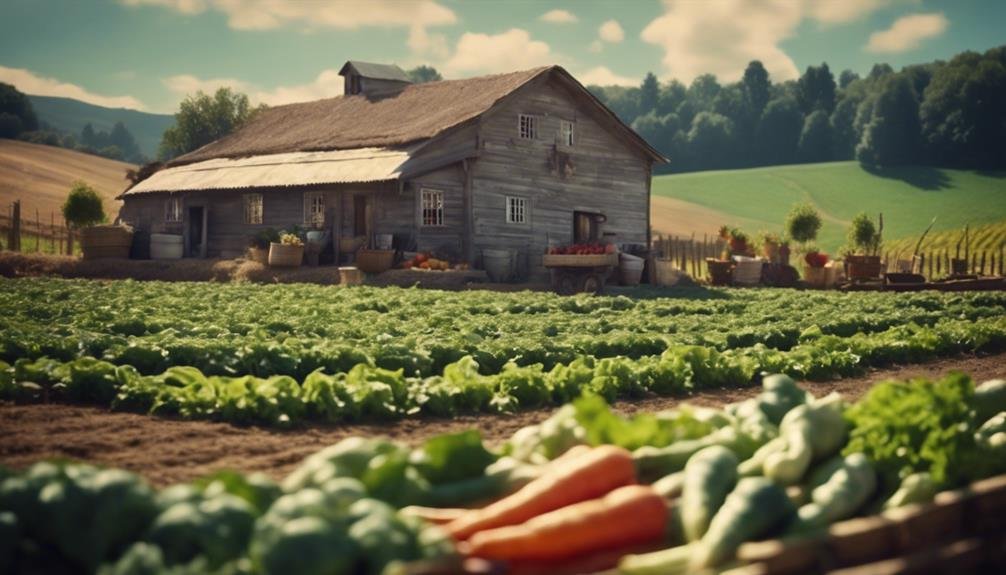Farm to Table: Starting Your Own Organic Farm
Starting your own organic farm is a journey that begins with the age-old adage, ‘you reap what you sow.’ But once the seeds are planted, the real work begins.
As you navigate through the process of turning your vision into a flourishing reality, there are key decisions to be made and strategies to be implemented. From choosing the right location to managing pests naturally, each step plays a crucial role in the success of your farm-to-table venture.
So, are you ready to take the first step towards cultivating a sustainable future?
Key Takeaways
- Select diverse organic crops based on soil suitability and pest resistance.
- Implement effective pest management strategies for sustainable farming.
- Engage with local markets and communities for direct sales and partnerships.
- Focus on customer relationships, quality products, and competitive marketing for business success.
Choosing the Right Location
When starting your own organic farm, selecting the ideal location is crucial for ensuring the success of your venture. The climate suitability and land size are key factors to consider. Choose a location where the climate aligns with the crops you plan to grow. Research the average temperature, rainfall, and frost dates to ensure they match the needs of your organic produce. Additionally, the size of the land should accommodate your current needs as well as any future expansion plans.
Water availability is another critical aspect to evaluate when choosing the perfect location for your organic farm. Access to an adequate and reliable water source is essential for irrigation and maintaining your crops.
Moreover, proximity to markets is vital for the success of your farm. Consider the distance to local markets, grocery stores, or restaurants where you plan to sell your organic produce. Being close to your target market can reduce transportation costs and ensure fresher products reach your customers.
Investing in the Right Tools and Equipment
Equipping your organic farm with the right tools and machinery is essential for efficiency and long-term success. Start by assessing the specific needs of your farm, considering factors such as soil type, crop selection, and the scale of your operation. Investing in high-quality hand tools, irrigation systems, and composting equipment can significantly improve productivity.
For soil preparation and cultivation, selecting durable and effective equipment is crucial. You can check this Yetter Poly Spike Wheels, which can enhance soil aeration and residue management, promoting healthier crop growth. Additionally, investing in a reliable tractor and appropriate attachments can save time and labor, allowing for more efficient farm management.
Prioritizing durable, multi-functional, and sustainable tools will not only optimize your workflow but also contribute to the overall health and success of your organic farm.
Selecting Your Organic Crops
When it comes to selecting your organic crops, the key lies in choosing a diverse variety that suits your farm’s needs.
You must also conduct thorough checks to ensure that the soil on your farm is suitable for the crops you wish to cultivate.
Crop Variety Selection
To cultivate a thriving organic farm, selecting the right crop varieties is the key foundation for success. When choosing your crops, consider pest resistance strategies and crop rotation techniques to maintain soil health and reduce the risk of infestations.
Look into organic fertilizer options to nourish your plants naturally and sustainably. Additionally, explore companion planting methods to create a balanced ecosystem that deters pests and encourages growth.
Soil Suitability Check
Ensure the soil on your organic farm is well-suited for the specific crops you plan to grow by conducting a thorough soil suitability check.
Start by performing soil testing to understand its composition and pH levels. This step is crucial for effective nutrient management, as different crops require specific soil conditions to thrive. By analyzing the soil, you can determine if any amendments are needed to optimize its suitability for your chosen crops.
Adjusting pH levels and addressing nutrient deficiencies will set the foundation for healthy plant growth and abundant harvests. Remember, healthy soil leads to healthy plants, so investing time in assessing and improving your soil’s quality will pay off in the long run.
Planning Your Farm Layout
Crafting a well-thought-out farm layout is the foundation for a successful organic farm. When planning your farm layout, consider aspects like plant spacing, companion planting, crop rotation, and weed management to optimize your farm’s productivity and sustainability.
To give you a visual representation, here’s a simple farm layout table:
| Crop Type | Plant Spacing | Companion Planting | Weed Management |
|---|---|---|---|
| Leafy Greens | 6-8 inches | Carrots | Mulching |
| Tomatoes | 18-24 inches | Basil | Hand weeding |
| Root Vegetables | 4-6 inches | Onions | Cover crops |
| Herbs | 8-12 inches | Chives | Crop rotation |
Implementing Sustainable Farming Practices
When it comes to making your organic farm truly sustainable, incorporating eco-friendly practices is key. To ensure the health of your soil and maximize crop yield, consider the following:
- Composting Techniques: Implementing composting practices on your farm can significantly reduce waste while providing rich nutrients for your soil. Start by collecting organic materials like kitchen scraps, yard waste, and manure to create nutrient-rich compost for your crops.
- Greenhouse Management: Utilize greenhouses to extend your growing season, protect delicate plants from harsh weather conditions, and control pests naturally. Implement proper ventilation, shading, and watering systems to create an optimal environment for your crops.
- Soil Health and Crop Rotation: Maintaining soil health is crucial for sustainable farming. Practice crop rotation to prevent soil depletion and reduce the risk of pests and diseases. Rotate crops seasonally to maintain soil fertility and structure, ensuring a bountiful harvest year after year.
Setting Up Irrigation Systems
Ready to elevate your organic farm? Let’s talk about setting up irrigation systems efficiently.
Watering seedlings with precision and reaping the benefits of drip irrigation can revolutionize your farming game.
Let’s dive into the world of sustainable water practices together!
Watering Seedlings Efficiently
To ensure optimal growth for your seedlings, consider implementing an efficient irrigation system to provide consistent and adequate water supply. Proper watering not only nurtures your plants but also promotes water conservation.
Here are three key points to help you water seedlings efficiently:
- Drip Irrigation: Minimizes water wastage by delivering water directly to the roots.
- Timer Systems: Automate watering schedules, ensuring your seedlings receive water at the right times.
- Mulching: Helps retain soil moisture, reducing the frequency of watering needed.
Implementing these techniques won’t only support seedling growth but also contribute to sustainable water usage on your organic farm.
Drip Irrigation Benefits
Maximize the efficiency of your irrigation system by understanding the significant benefits of drip irrigation for your organic farm. Drip irrigation offers water-saving techniques and efficient systems that can revolutionize the way you water your crops.
By delivering water directly to the base of plants, drip irrigation minimizes water waste through evaporation and runoff. This sustainable method not only conserves water but also promotes healthier plant growth by providing consistent moisture to the roots.
Embracing drip irrigation on your farm showcases a commitment to sustainability and reduces the environmental impact of traditional watering methods. Invest in drip irrigation to optimize your water usage, increase crop yields, and contribute to a greener agricultural future.
Managing Pests Naturally
When cultivating your organic farm, combating pests naturally is essential for maintaining a healthy and sustainable environment. By employing eco-friendly pest management techniques, you can protect your crops without harming beneficial insects or the environment. Here are some effective methods to manage pests naturally:
- Beneficial Insects and Companion Planting: Introduce beneficial insects like ladybugs, lacewings, or praying mantises to your farm. These insects prey on common pests, keeping their populations in check. Additionally, practicing companion planting by growing pest-repelling plants alongside your crops can help deter unwanted insects.
- DIY Natural Pesticides: Create your own natural pesticides using ingredients like neem oil, garlic spray, or soap solution. These alternatives are safe for your plants, animals, and the environment while effectively controlling pest infestations.
- Crop Rotation: Implementing crop rotation techniques can disrupt the life cycles of pests, reducing their numbers over time. By rotating your crops seasonally, you can prevent pests from establishing permanent habitats and protect the overall health of your farm.
Harvesting and Selling Your Produce
Enhance the freshness and appeal of your organic produce by mastering efficient harvesting techniques and strategically marketing your bounty to eager customers. When it comes to harvesting, timing is crucial. Pick your fruits and vegetables at peak ripeness to ensure the best flavor and nutritional value. Invest in high-quality harvesting tools to streamline the process and minimize damage to your crops.
To sell your produce successfully, consider different marketing strategies and pricing tactics. Engage with your local community by forming partnerships with restaurants, grocery stores, or schools. Participating in farmer’s markets is a fantastic way to directly connect with consumers who value organic, locally-sourced products. Create eye-catching displays, offer samples, and share your farm’s story to attract customers.
Set competitive yet fair prices that reflect the quality of your organic produce. Consider offering discounts for bulk purchases or creating subscription boxes for regular customers. By building strong relationships with your community and implementing effective marketing strategies, you can establish a loyal customer base and ensure the success of your organic farm.
Conclusion
Now that you’ve learned the basics of starting your own organic farm, get ready to embark on this exciting journey!
With hard work and dedication, you’ll be amazed at the bountiful harvests you’ll reap.
So roll up your sleeves, dig in the dirt, and watch your farm flourish into a green paradise.
Get ready to experience a world of flavor and freshness like never before!
It’s time to unleash your inner farmer and let your organic dreams grow wild!







